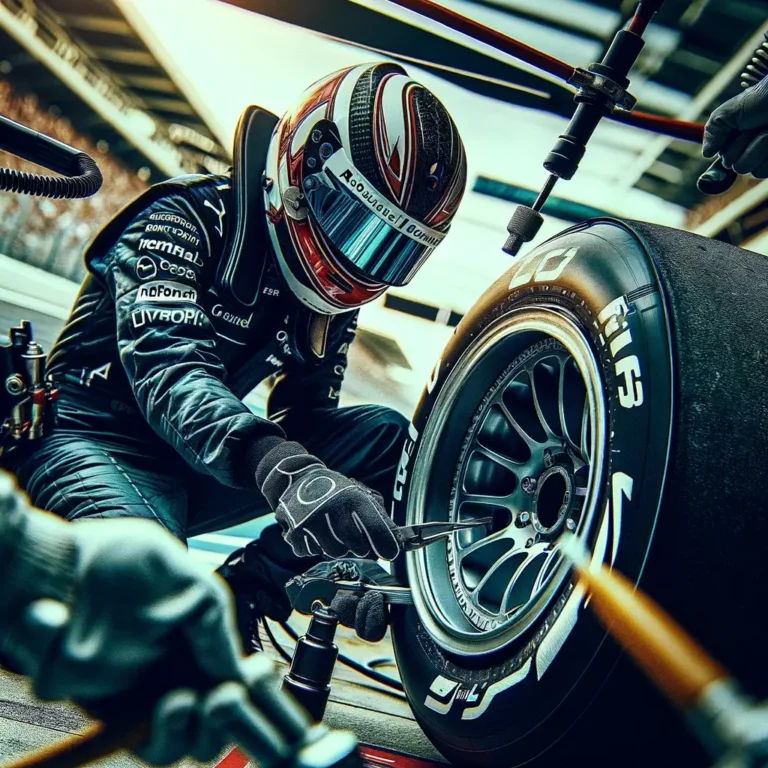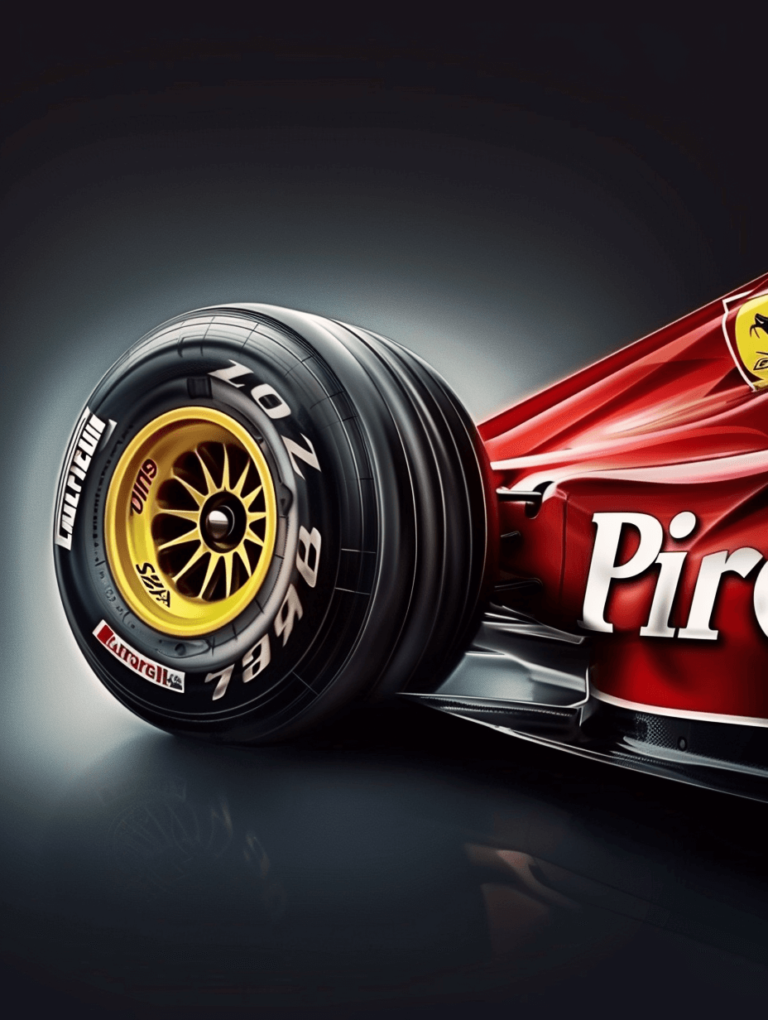Explore how Formula 1 tires have transformed over the years, improving car performance and driver safety on the track.

During a recent Formula 1 race in Saudi Arabia, my daughter and I found ourselves deeply engrossed in the high-speed action and the incredible performance of the cars. As the race unfolded, our curiosity was particularly piqued by the F1 tires – the only point of contact between these engineering marvels and the track. We wondered about the technology behind them, how they withstand the intense conditions of a race, and the strategy involved in selecting the right compound for different stages of the race.
This sparked a delightful and educational discussion between us, and it was this conversation that inspired me to dive deeper into the world of F1 tires. Wanting to share our newfound knowledge and interest, I decided to write this blog, hoping to unravel the complexities and innovations that make F1 tires a key factor in the thrilling sport of Formula 1 racing.
Introduction to Formula 1 Tires
Formula 1 tires have been a critical component of the sport since its inception, undergoing significant evolution to meet the demands of ever-increasing speeds and the quest for safety. The history of tire use in Formula 1 is marked by constant innovation, with tire manufacturers like Pirelli, Michelin, and Goodyear playing pivotal roles in shaping the performance of F1 cars.
In the early days, tires were narrow and made from very basic rubber compounds. Over the decades, the introduction of wider tires, improvements in rubber compounds, and the development of wet and slick tire options have significantly influenced racing strategies and outcomes.
Tires are fundamental to the performance and safety of Formula 1 cars. They are the only point of contact between the vehicle and the road, making their role in acceleration, braking, and cornering paramount. The right tire choice can dramatically affect a car’s handling and speed, as well as how it wears over the course of a race. Furthermore, tires have been central to safety improvements within the sport.
For example, in 2005, Formula 1 banned tire changes during a race to encourage the use of harder tires, thus lowering cornering speeds and promoting safety. Additionally, the introduction of standardized tire barrier inserts in 2000 by the FIA enhanced energy absorption during crashes, further underscoring the role of tires in the safety of the sporbut t.
Overall, the evolution of Formula 1 tires reflects a balancing act between enhancing performance and ensuring safety. As technology advances, tire development continues to be at the forefront of Formula 1, influencing race strategies, driver performance, and safety outcomes.
Types of Tires Used in F1
In Formula 1, tire compounds and selection play a crucial role in the strategy and performance of the cars. Pirelli, the sole tire supplier, offers a range of tire compounds designed to suit various track conditions and strategies. These compounds include soft, medium, hard, intermediate, and wet tires, each with distinct characteristics and strategic uses.
Soft Compound Tires: Soft tires are made from a softer rubber compound that provides a high level of grip and traction. However, they wear out faster than harder compounds. Soft tires are preferred in conditions where maximizing grip is crucial, often used in qualifying sessions for faster lap times and in certain race situations where a high grip is essential for short stints.
Medium Compound Tires: Medium tires strike a balance between grip and durability. They offer a compromise between the high grip of soft tires and the increased durability of hard tires. Teams often use medium tires in race conditions where a balanced approach between speed and tire longevity is required.

Hard Compound Tires: Hard tires are made from a harder rubber compound that offers the highest durability but at the cost of grip compared to softer compounds. These tires are suitable for tracks with high abrasive surfaces or in race conditions where minimizing pit stops is a strategic priority.
Intermediate Tires: Intermediate tires are designed for wet conditions that are not wet enough to necessitate the use of full wet tires. They have a tread pattern to displace water, offering grip in mildly wet or drying conditions. Intermediate tires are crucial for transitional weather conditions.
Wet Tires: Wet tires, also known as full wets, have a deep tread pattern to manage heavy rain conditions. They are capable of displacing significant amounts of water to prevent aquaplaning. Wet tires are used during heavy rain to ensure safety and performance when the track is soaked.
The choice of tire compound and when to use each type is a critical strategic decision in Formula 1. Teams must consider the track characteristics, weather conditions, and race strategy when selecting their tires for a race weekend, balancing the trade-off between speed, grip, and tire wear.
Regulations Governing Tire Use
The FIA (Fédération Internationale de l’Automobile) plays a pivotal role in regulating tire use in Formula 1, ensuring safety, fairness, and competitiveness across the sport. One of the core aspects of their regulation is the imposition of mandatory tire changes during a race and strict guidelines on tire compounds selection for a race weekend.
Mandatory tire changes are designed to add strategic depth to races and ensure driver safety through the use of appropriate tires for varying conditions. During a race, drivers are required to use at least two different types of dry tire compounds, unless weather conditions necessitate the use of wet or intermediate tires. This rule introduces a crucial strategic element to the race, as teams must decide the optimal timing and choice of tire compounds to maximize performance and adapt to changing conditions.
Regarding the selection of tire compounds for a race weekend, the FIA, in collaboration with the official tire supplier (currently Pirelli), mandates the use of specific tire compounds. This selection varies for each Grand Prix to suit the characteristics of the circuit and expected conditions. For instance, for the 2023 season, Pirelli provides a range of six slick compounds from C0 (the hardest) to C5 (the softest), along with wet and intermediate options.
Teams are informed in advance which three compounds are available for a given race, and they must choose their allocation from these options. Furthermore, regulations stipulate the use of particular compounds during different phases of qualifying, adding another layer of strategy to tire management.
The FIA’s regulations on tire use are crucial for maintaining the competitive integrity of Formula 1, ensuring driver safety, and enriching the strategic complexity of the sport. These rules require teams and drivers to make judicious decisions on tire management, significantly impacting race outcomes.
F1 Racing Tire Management Strategies
Tire management is a critical aspect of Formula 1 racing, pivotal for achieving optimal performance and a key factor in the strategies that teams and drivers employ during both qualifying sessions and races.
Effective tire management can significantly impact the outcome of a race, as it influences the car’s speed, handling, and overall race strategy.
The importance of tire management stems from the need to balance speed with the preservation of tire life. Tires that are pushed too hard too early can degrade quickly, leading to loss of grip and increased lap times.
Conversely, conservatively managed tires may not extract the maximum performance from the car, potentially losing positions on track.

The challenge for teams and drivers is to find the optimal balance that maximizes tire performance throughout the stints, ensuring that the tires are in the best possible condition for the critical moments of the race.
Several techniques are employed by teams and drivers to preserve tire life:
Optimizing Tire Temperatures: Managing the temperatures of the tires is crucial. Too high temperatures can cause overheating and rapid degradation, while too low temperatures may result in insufficient grip. Teams use data analytics to find the ideal temperature range for their tires.
Strategic Pitting: Choosing the right moments to pit and change tires can help in managing tire wear. The strategy involves deciding whether to push for longer stints on a single set of tires or to opt for shorter stints with more frequent tire changes.
Driving Techniques: Drivers can adopt smoother driving styles, avoiding aggressive acceleration, braking, and steering movements that can exacerbate tire wear. Maintaining clean lines through corners and minimizing sliding can also help preserve tire life.
Race Strategy Adaptation: Teams must be ready to adapt their strategy based on tire performance during the race. This includes adjusting the race pace, managing traffic effectively to run in clean air, and responding to changing track conditions.
Technological Innovations in Tire Design
Technological innovations in tire design have significantly advanced in recent years, impacting both the performance and durability of tires. These advancements encompass a variety of areas, including materials, tread patterns, and overall tire construction. Innovations such as silica-reinforced tread compounds have emerged, enhancing grip on wet surfaces, reducing rolling resistance, and improving fuel efficiency without sacrificing the tire’s durability. Such materials not only offer better performance but also contribute to the tire’s longevity.
The introduction of new tread patterns and sidewall designs has also played a critical role in today’s higher-performing tires. These innovations have made tires more reliable, offering improved handling and safety for drivers. The continuous evolution in tire technology aims at providing a balance between durability, performance, and safety, ensuring that tires can withstand diverse driving conditions while delivering optimal performance.

Moreover, the tire industry is witnessing the emergence of smart tire technologies, such as sensors that provide real-time data on tire health, air pressure, and temperature. These advancements allow for proactive maintenance, reducing the likelihood of tire failure and enhancing safety. Airless tires, another groundbreaking innovation, promise unprecedented durability by eliminating the risk of punctures, thereby offering a more reliable and maintenance-free solution.
The impact of these technological advancements on tire performance and durability is profound. Improved materials and design have led to tires that offer better grip and handling, longer life, and greater fuel efficiency. Additionally, the integration of digital technologies into tire design is setting the stage for smarter, safer, and more eco-friendly driving experiences. As tire technology continues to evolve, the benefits extend not just to individual drivers but also to the broader aspects of transportation and the environment.
Challenges and Controversies Surrounding Tires in F1
Tire-related incidents and the debate over tire regulations have significantly shaped the landscape of Formula 1 (F1), highlighting the critical role tires play in the sport’s safety, competitiveness, and entertainment value.
One of the most notable tire-related incidents in F1 history is the 2005 United States Grand Prix, where tire safety concerns led to a majority of the teams withdrawing from the race, leaving only six cars to compete. This event underscored the importance of tire reliability and sparked discussions on tire regulations and safety standards.
In recent years, Pirelli, the sole tire supplier for F1 since 2011, has faced challenges, including incidents of tire failures that led to dramatic moments in races. For example, investigations into tire issues during the Qatar Grand Prix uncovered problems that brought the topic of tire safety back into the spotlight, illustrating the ongoing challenges tire suppliers face in ensuring their products meet the rigorous demands of F1 racing.
The debate over tire regulations revolves around balancing performance, safety, and competition. Regulations dictate aspects such as tire compounds available for races, mandatory tire changes, and the allocation of tires. These rules aim to ensure safety and fairness while also adding strategic depth to the races.
However, they have also sparked debates on whether they overly dictate the outcome of races or if more freedom should be given to teams in tire selection to encourage diversity in race strategies.
Overall, the challenges and controversies surrounding tires in F1 underscore the complex relationship between tire technology, regulations, and the sport itself. As F1 continues to evolve, the development of tire regulations and technologies will remain a pivotal area of focus, aiming to enhance safety, performance, and the racing spectacle.
The Future of Tires in Formula 1
The future of tires in Formula 1 is poised for significant evolution, with a strong emphasis on advanced technology, innovative regulations, and, importantly, sustainability.
Recent developments indicate a shift towards tires that not only enhance the performance of F1 cars but also align with environmental objectives.
One of the most notable changes is Formula 1’s move towards Pirelli FSC-certified tires. This transition marks F1’s commitment to embracing more sustainable practices by ensuring that the natural rubber used in tire production complies with the Forest Stewardship Council® (FSC®) standards, which include stringent environmental and social criteria.

This initiative is part of a broader strategy to increase the sustainability of the sport and reduce its ecological footprint.
Additionally, tire manufacturers are focused on reducing the overall impact of tires by bringing fewer tires to the racetrack. This approach not only addresses the issue of tire waste but also encourages teams to adopt more strategic and efficient use of tires, potentially leading to changes in regulations around tire allocation and usage during race weekends.
The drive towards sustainability in tire technology does not overlook performance. Innovations in tire design and materials aim to enhance durability, fuel efficiency, and overall performance. These advancements include the development of airless tires, smart tire sensors providing real-time data, and materials that offer better grip and longer life.
As Formula 1 continues to evolve, the role of tire technology and regulations will be crucial in balancing the demands of high-speed racing with the imperative of sustainability. The future will likely see tires that are not only faster and safer but also more eco-friendly, underscoring the sport’s commitment to innovation and environmental responsibility.

